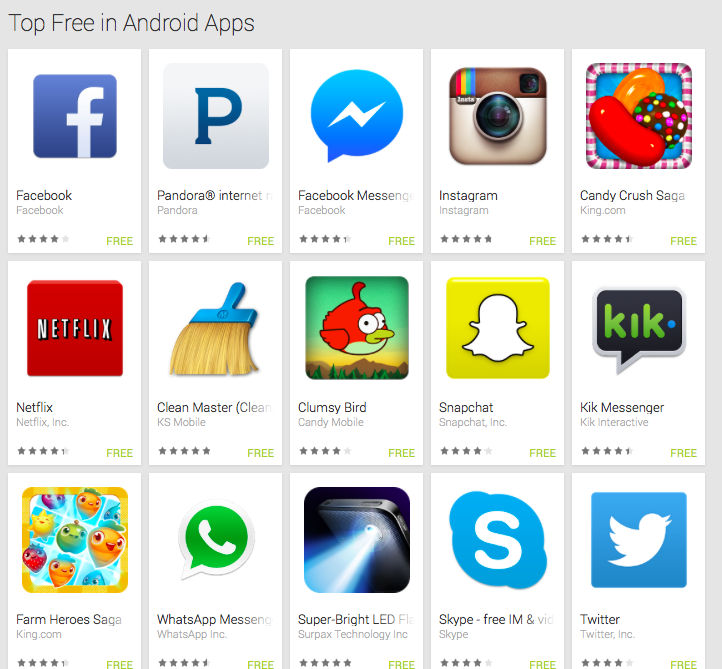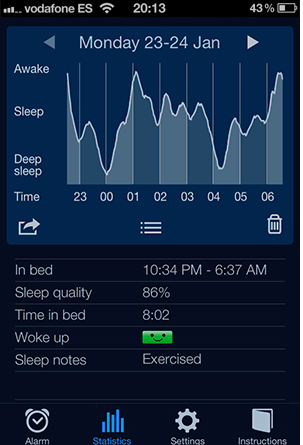by scott.gillum | Mar 6, 2014 | 2014, Tech Trends
I had a dream last night that I was hiking along a stream with my family. The same path we’ve hiked and geocached dozens of times. Except this time, Siri’s voice interrupted our hike and asked if we’d like to play a game.
An app I had downloaded came on, and using GPS, our hiking history, and topographical maps of the area, had created a real time obstacle course, complete with the map, times to achieve, and “land mine” rocks to avoid. The “App” had proactively invaded our routine hike by creating a totally new experience.
When I awoke I wondered if I had read this, or if it was truly a dream. Concluding that it was a dream, I knew the article that helped to “inspire” it, and perhaps, playing a little too much Candy Crush may have lead to the creation of the “land mines”.
Earlier in the week, I had read about fitness apps that, for the first time, were positively impacting behaviors. I thought it was noteworthy because even with time spent on mobile devices continuing to grow, we have not invited them into our lives as an active participant, although my teenager may disagree with me. In 2013, Gartner reported consumers spent an average of 2 hours and 28 minutes per day on devices (phone and tablet), and 80% of that time spent inside apps.
Apps have been in “ondemand” mode waiting for us to engage. They haven’t been invited “in” because, for the most part, they haven’t been smart enough to provide us with value. With the era of the “internet of everything” we are entering a new world of connectedness. With devices able to communicate with each other, and soon apps, is this the beginning of new phase of app development?

An era that goes beyond the first generation of “dumb” apps, similar to “dumb terminals” of yesteryear, in that they, with a few exceptions, mostly games, are nothing more than version of existing websites that have been optimized for mobile devices.
Next generation “smart” apps will have the potential to become an active part of our lives by tracking, and understanding our unique behaviors and habits, to creative highly personalized recommendations and experiences. But by 2017, Gartner predicts that mobile apps will have been downloaded more than 268 billion times, and mobile users will provide personalized data streams to more than 100 apps and service every day
Our mobile devices, which many of us carry 24/7, can remember where we’ve been, what we’ve done, and when we did it. They can listen in on our conversations, as we’ve learned, and can access data we have stored on the device and in the cloud.
As a result, be on the watch for the following in the near future:
- The emergence of “small data” – the value and functionality of your mobile device will shift from connectivity to data capture and transfer. In a sense, your phone will act as your own “black box” recording your daily activity, similar to a flight recorder. Apple and Google have the ability to track activity across devices so that most of your waken hours will be captured.
- A “listening” mode on your phone – it already exists the difference is that it will be a setting you control (instead of others). This will add a layer of richness to the data that is already being collected and enable apps to pick their spots to intervene with information, recommendation, etc.
- Highly personalized experiences – apps will leverage multiple sources of data and with artificial intelligence begin to create experiences and recommendations in real time, much of it designed around our daily lives and routines.
- Intelligent Ads – yes, someone has to pay for the free apps and advertisers will be at the ready. As the apps get smarter, so will marketers! Ads will appear at the right time, with relevant offers based on your interest, past buying behavior, and preferences. Some will be rewards based on certain behaviors, and other offers will incent them.

Signs of these types of apps are starting to appear. Apps like the Sleep Cycle alarm clock, that gently wakes you by analyzing your sleep patterns. Using your iPhone as an accelerometer, Sleep Cycle monitors your movement to determine which sleep phase you are in (see the image on the right). Once learned, the phone alarm then wakes you with soothing sounds in your lightest sleep phase.
Think of the convenience of having an app on your phone listen in on conversations when you’re traveling abroad and translate, in real time, in the dialect of that region. Or, as in my dream, the value of taking a routine outing and creating a totally new and highly engaging experience.
Of course progress comes with a cost. Increasing the availability of personal data also increases the threat of those who would like to get their hands on it. In fact, it will slow the progress of this smart app generation. That said, we will see improved security built into devices, and hopefully, there will be “an app for that” as well.
by scott.gillum | Dec 17, 2012 | 2011, Tech Trends
Original post date 11/29/11
With the Christmas shopping season fully upon us, Microsoft’s Kinect motion-sensing game device is expected to be at the top of the gift list for many consumers. Last year, Microsoft sold 1 million Kinect devices for its Xbox 360 in 10 days, and in a recent poll it was at the top of the wish list for children 13 and older. But what you might not expect is that some of those orders are going to be coming from businesses.
Early this month, Microsoft launched Kinect for Windows SDK with a brilliant, new ad called “Kinect Effect.
The Kinect Effect TV Ad
Microsoft is pushing Kinect hardware for Windows SDK for business applications. As staff writer Jason Kennedy from PCWorld states: “SDK will make it possible for programmers and dreamers from the world over to tinker with the system and make it do things Microsoft hadn’t thought of, and push the development of NUI [natural user interfaces] to the next level.”
What is noteworthy about the Kinect Effect ad is what it took for Microsoft to make it. Six years ago, in an interview with CMO magazine, Microsoft CEO Steve Ballmer confessed to a problem long known by many consumers of Microsoft products:
During Microsoft’s climb to the top of the software industry, rapid-fire product cycles often happened without much front-end input from the folks in marketing. Engineers would develop new software, pack it with bells and whistles, decide on an acceptable number of bugs and toss it over to marketing for a press release and a launch event.”
At the time, Microsoft had set out to change that course through an expansive and expensive relationship marketing initiative. Internally, it aligned marketing with product groups, created a “mea culpa” marketing campaign to reach out to past customers, and targeted loyalists hoping to turn them into advocates.
But because of its past transgressions, and a perception that many of its products were “necessaries” with little to pique the desire of consumers, Microsoft struggled with finding an ignition point, or something to connect customers with the brand and ignite their passions.
Well, those days appear to be over. With the Kinect Effect, the tech titan proves that it can be relevant, even desirable, with a campaign that is expansive, inspiring and incredibly human. The campaign asks audiences to dream about how they might use Kinect by inspiring them with images of people playing air instruments, a doctor flipping through X-rays, and a student deconstructing DNA with only hand motions.
The expansiveness of the idea allows Microsoft to reach, and hopefully inspire, all three of its targeted audiences, including consumers/users, businesses and developers. Any one group can have the dream, but all three are needed for it to become reality.
Perhaps the most significant point of the ad is that it’s proof that the relationship marketing effort was a success, Microsoft now understands the strategic importance of the “front end” as Ballmer calls it. Five years ago the message of the commercial would of been about the “bells and whistles” of the Kinect device. This ad is an elegant and visually stimulating vision of what Kinect can enable, the virtually unlimited imagination of dreamers.
If Microsoft can continue to build this connection with the customer while retail store openings roll-out into 2012, it could transition itself from the company that makes the “have to have” product to the company that is the “want to have” brand.
by scott.gillum | Dec 6, 2012 | 2012, Tech Trends
Years from now, will we look back and realize that Apple’s biggest innovation was not device, but rather a physical gesture?
The right-to-left swiping motion used with Apple devices to sort through photos or to navigate certain apps is quickly altering how we seek and absorb information.
David Payne, chief digital officer of Gannett & Co. Inc., parent company of USA Today, delivered this point eloquently at the 2012 Mid-Atlantic Marketing Summit. In his opening speech, he pointed out that the digital world changed when Apple introduced “touch” with the iPod and iPhone.
Touch screens had been around for years, but Apple brought them into our daily lives, in particular with the iPhone. As a result, the way we engage and interact with devices has changed, as evidenced by the dramatic decline in sales of the BlackBerry. And now with the explosive growth of the iPad, it’s about to change again. This time, though, it will be even more dramatic.
Payne referred to the “swipe” as the game-changer, or as he called to it, “petting the cat.” This new right-to-left world has caused Gannett to rethink the traditional “top-to-bottom” experience of its websites, in particular how it organizes content. As evidence, Gannett has incorporated this new “petting the cat” thinking into its new USA Today app (it’s worth downloading).
Last week, Fast Company ran a story on a new technology MIT developed that enables users to drag files across devices with a swipe. Coincidentally, it’s called Swyp. Nathan Linder, a PhD student in the fluid interfaces group at the MIT Media Lab, said, “Our framework allows any number of touch-sensing and collocated devices to establish file-exchange and communications with no pairing other than a physical gesture.”
Apple’s impact on design has enjoyed much acclaim and is noticeable in almost any new technology designed. But what may be overlooked is the impact Apple has had on the user experience and how users interact with technologies. And that impact goes far beyond just Apple devices.
For example, one attendee mentioned that his 3-year-old went up to the television and tried to “swipe” it to change the channel. A colleague mentioned that she is constantly cleaning her computer screen because her kids try to open photos on her desktop by touching them. Apple has, and continues to have, the ability to change consumer behaviors, requiring the rest of the world to catch up.
Marketers must now realize that we are a step behind. We recognize the importance of adapting digital assets to fit the device, but we haven’t thought through the ramifications of “petting the cat” behavior. The swipe is here to stay. It’s now time to reset our navigation point from North to South to East to West.








